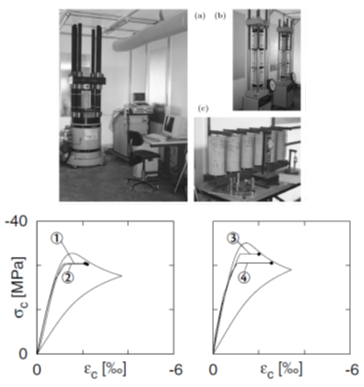|
Concrete long-term behavior is not limited to deformations caused
by creep and shrinkage. Inelastic deformations are also caused by
high levels of stresses. These deformations, due to microcracking
phenomena in concrete, are related to fatigue under sustained
loading and can also lead to failure of concrete under compression
in the long term.
This phenomenon has been investigated by the Structural Concrete
Laboratory by developing a constitutive model of concrete that
includes the development of microcracking in concrete. This model
has been validated by an experimental campaign and has led to
further developments (constitutive laws for concrete) that are
integrated in the research activities of the Laboratory.
|

|
Reference publications
Effect of sustained loading on concrete strength
- Tasevski D., Fernández Ruiz M., Muttoni A., Compressive Strength and Deformation Capacity of Concrete under Sustained Loading and Low Stress Rates, Journal of Advanced Concrete Technology, Japan, 2018, pp. 396-415.
- Fernández Ruiz M., Muttoni A., Gambarova P., Relationship between nonlinear creep and cracking of concrete under uniaxial compression, Journal of Advanced Concrete Technology, Vol. 5, No 3, Japan, 2007, pp. 383-393.
Cyclic loading
- Drakatos I.-S., Muttoni A., Beyer K., Mechanical Model for Drift-Induced Punching of Slab- Column Connections without Transverse Reinforcement, ACI Structural Journal, V. 115 No. 2, Farmington Hills, USA, 2018, pp. 463-474.
- Drakatos I.-S., Muttoni A., Beyer K., Internal slab-column connections under monotonic and cyclic imposed rotations, Engineering Structures, 123, 2016, pp. 501-516.
Fatigue
- Fernández Ruiz M., Zanuy C., Natário F., Gallego J.M., Albajar L., Muttoni A., Influence of Fatigue Loading in Shear Failures of Reinforced Concrete Members without Transverse Reinforcement, Journal of Advanced Concrete Technology, vol. 13, Japan, 2015, pp. 263-274.
- Natário F., Fernández Ruiz M., Muttoni A., Experimental investigation on fatigue of concrete cantilever bridge deck slabs subjected to concentrated loads, Engineering structures, 89, 2015, pp. 191-203.
|
